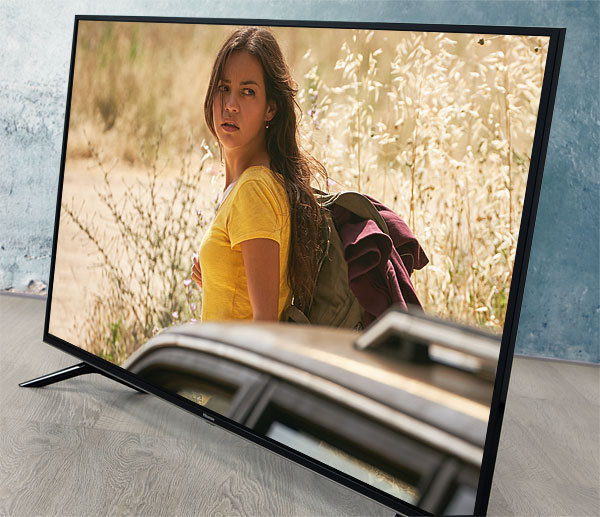Hisense R50B7120 Roku TV review

 John Archer is very 'appy to get acquainted with the UK's first Roku-enabled smart TV
John Archer is very 'appy to get acquainted with the UK's first Roku-enabled smart TV
While our American friends have had 'Roku TVs' for half a decade now, the Hisense R50B7120 marks the first time the renowned smart platform has shipped built into a UK set. I can't say for sure why it's taken so long for a Roku-powered flatscreen to rock up here. What I can say, though, is that many households should be very happy to see it.
If you're not familiar with Roku, it's essentially an independent smart platform designed to aggregate a huge array of apps and TV services under one easy-to-use interface. The company has been around since 2008, and in that time it's both signed carriage deals with just about every streaming platform under the sun, and perfected the art of making all that content manageable via an ultra-robust, straightforward interface.
Originally Roku's platform was only available on external streaming players and HDMI 'sticks'. But while those options are still very much out there, it's easy to understand why incorporating Roku's interface and options into a TV seems like a no-brainer. Provided, of course, that building Roku into a TV doesn't hamstring it too much.
Not a follower of fashion
Before I get into that, a word on the Hisense B7120's design. The frame around its 50in screen is fairly wide, and the rear sticks out quite a bit. The black feet look and feel rather functional, too, while both the chassis and its attendant remote control feel lightweight and plasticky.
The 50in R50B7120 – there are 43in, 55in and 65in alternatives – is not one of Hisense's 'ULED' models. This means it doesn't have local dimming for its backlight; a Quantum Dot-generated wide colour gamut; or Hisense's UltraSmooth motion processing.
In other words, Hisense has decided that the best place to debut built-in Roku in the UK is on a relatively entry-level TV. In fact, quite astonishingly, at the time of writing it was selling for just £300. Which probably explains the bland styling.
The Roku smart platform isn't the R50B7120's only potential attraction. The TV uses a direct LED lighting system rather than an edge-based engine, which usually helps contrast even when there's no local dimming in play, and it's 4K (of course) with HDR playback – although unlike Hisense's latest ULED models, there's no support for Dolby Vision or HDR10+. The TV enjoys an outstanding input lag of just 12ms with the Game preset selected, and with Game mode off still musters a solid 29ms.
Connections include three HDMI 2.0 ports, and a single USB port for playing multimedia files. There's HDMI ARC, but not eARC.

Planet of the apps
The all-important Roku platform turns out to have been integrated very effectively. During initial installation, for instance, you're directed to your PC or mobile device to set up your Roku account and choose your initial apps. This is far preferable to messing about in the TV's menus.
If you do explore Roku's full app store on the TV post- installation, though, prepare for a shock. In the Film and TV section alone, for example, there are more than 900 apps to peruse. There are also nearly 300 games, as well as nearly 90 general infotainment apps, and a thousand(!) different screen savers.
Obviously many of the Roku platform's apps are niche to say the least. But compared with the home-grown smart systems of Samsung, LG and Panasonic, Roku TV is in a content-rich class of its own. And yet it still keeps access to all this stuff clean and straightforward.
Furthermore, all the big hitters are present and correct, including Apple TV, Netflix, Amazon Prime Video, Now TV, YouTube, Rakuten, Google Play, Spotify and Freeview Play.
The Roku interface treats apps, the TV's Freeview HD tuner, and each of its AV inputs equally, so that they all appear as a direct access icon on your home screen rather than in separate menus.
The interface arguably looks basic by today's standards, lacking features such as the contextual 'pop out' secondary tier of content links you get with competitor smart TV systems. But Roku is devoted to simplicity – and keeping 'clutter' off the screen is key to that.
Another brilliant advantage of Roku's platform is how easy it is to run. The Hisense R50B7120 is about as far from a high-end TV as you can get, yet the Roku UI is slick, with no apparent bugs, and never slows down any other aspect of the TV's menus.
Roku also lets you control the R50B7120 from your smartphone or tablet via its tidy and effective iOS or Android app, which also makes it easy to share photos, music and video from your phone/tablet to the TV. The app also supports 'private listening', letting you shunt the TV's sound to your smart device headphones while the Hisense remains silent – potentially a very useful feature for some.
The app even carries expert settings (white balance adjustment, colour management, gamma adjustment and so on), rather than complicating the TV's built-in menus with such specialist-only features.
 |
Home Cinema Choice #351 is on sale now, featuring: Samsung S95D flagship OLED TV; Ascendo loudspeakers; Pioneer VSA-LX805 AV receiver; UST projector roundup; 2024’s summer movies; Conan 4K; and more
|

















































